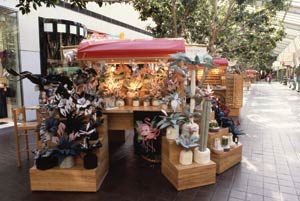8/1/2008
Carts, Kiosks & Temporary Tenants
Joseph Weishar

The success of carts, kiosks and temporary sales spaces typically found in shopping centers and malls happened quickly. At first opposed by the permanent retail tenants, these temporary retail merchandising units (RMUs) did what competition does—increased activity and sales for all adjacent businesses. From shopping destinations like Boston’s Fanuiel Hall and New York City’s South Street Seaport to your local mall, RMUs have become an important method for keeping many shopping center spaces viable and open for business.
RMUs sell all types of merchandise, from food and beverages to jewelry. Sales from these units for temporary tenants can quickly exceed $500,000 during Christmas. They provide an outlet that shouldn’t be overlooked for its potential to tap into a market both for sales of current items and to introduce your company to a wider audience.
Before setting out to rent space in the local mall, it’s important that you select a shopping center that has the highest traffic and best reputation in the region. You can make a profit in lesser selling spaces, but if you’re going to put in the effort, your original expenses will be more than covered by the sales and activity in the shopping center. Second, and no less important, a high-traffic location can put you in front of new customers.
When should you consider setting up temporary shop? What type of products should you display? How do you manage this and your current home operation? What can you expect immediately and subsequently? Where is the best location for your product? These are just a few questions that retailers ask as they explore their RMU options.
Timing
The obvious answer to “when” follows the normal merchandising cycle—when people give flowers for Mother’s Day, Christmas, spring planting, fall planting of bulbs, and even everyday gifts such as houseplants and bonsai trees. Timing your merchandise offering with the season is important; however, setting up shop in the temporary location one or two weeks before the active selling time allows the typical shopper to recognize and link the product with the mall.
The products that you show can be general merchandise, decorative planters, dry flowers, sprays, bird feed, hand tools, books or candles. You can also sell planting, maintenance and other garden-related services. Giving advice on plant care will always attract a group of customers. Use your educated and trained staff horticulturists in the center and watch the crowds gather. Your best product is your knowledge. It’s the strategy that makes Apple so successful. They teach before they sell.
Managing expectations
How do you manage a temporary location such as a cart or kiosk along with your regular business? If you don’t give it the best possible talent you have, the results will never be as successful as you’d like. Don’t assume you can hire a “babysitter” to manage your products and information.
Without prior experience with temporary retail units, you may not know what types of sales to expect, or even if customers will accept your presence. If you’re the adventurous type, you can expect that your efforts might be rewarded more than you will have ever experienced. Here’s one word of caution: Do not run out of stock! When someone finds a new and exciting product and tells her friend about it, you don’t want to be out of stock when the friend comes to have a look herself!
Location
As customers circulate through a mall, they typically pass a center court location as they both come and go. In this location they’ll see all sides of your unit. Most of your garden-related items might be considered as items to purchase prior to exiting the shopping center. This means that the side of your retail unit that will get the most attention should be facing away from the entry doors, and that side will have the most buying activity as shoppers exit. The side facing the mall’s entry will be used most effectively as an advertisement of your presence.
There’s much more to discuss about timing, product selection and merchandising your RMU. I can only say if properly located and timed just right, you’ll have unimagined success with your best-selling items.
Joseph Weishar is the founder and president of New Vision Studios in New York City. He is a firm believer that successful stores have an intuitive aesthetic balance. He can be reached at (212) 686-7200 or
newvisioninc@earthlink.net.